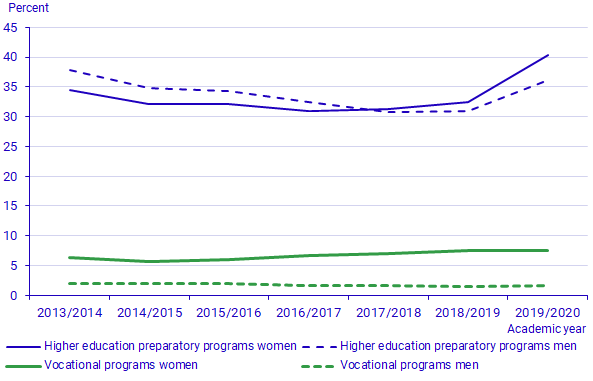Transition upper secondary school – post-secondary education, upper secondary school graduates 2013/14-2019/20
More upper-secondary school graduates chose higher education studies during the pandemic
Statistical news from Statistics Sweden 2021-11-11 9.30
The proportion of those who started higher education studies within one year increased considerably among pupils who graduated from a higher education preparatory upper secondary programme in spring 2020. This increase was larger among women than among men.
In spring 2020, just over 80 500 people graduated with an upper secondary qualification. Among those, 22 300 people commenced higher education studies within one year, which corresponds to 28 percent. Most of them had attended a higher education preparatory programme in upper secondary school. The previous year, 23 percent had commenced higher education studies.
Compared with the previous year, the increase was largest among women who had a qualification from a higher education preparatory programme. Among women who graduated in spring 2020, 40 percent started further studies within one year, compared with 32 percent among those who graduated in spring 2019. Corresponding figures for men are 36 percent, and 31 percent among those who graduated in spring 2019.
Among graduates from vocational programmes, there is no difference between the two most recent academic years in terms of transition within one year.

More students choose to study independent courses
Students most commonly enrol in a programme leading to a professional qualification, such as medical doctor or engineer. Among all those who graduated in the academic year 2019/20 who commenced higher education studies within one year, 47 percent chose to study a programme leading to a professional qualification, compared with 51 percent the previous year.
However, the number of students who chose a programme leading to a professional qualification had not diminished; the lower percentage can be explained by a larger overall number of people studying and that more people chose to study independent courses. The proportion of students who started studying independent courses was 28 percent, compared with 24 percent the previous academic year. A possible explanation for this increase is that people who normally would have chosen to work after graduating from upper secondary school instead chose to study independent courses while waiting for a better situation on the labour market.
| People with an upper secondary qualification 2018/19 | People with an upper secondary qualification 2019/20 | ||||||
|---|---|---|---|---|---|---|---|
| Total | Women | Men | Total | Women | Men | ||
| Number of people who continued studies within one year | 17 857 | 10 048 | 7 809 | 22 267 | 12 775 | 9 492 | |
| Number of students in a programme leading to a professional qualification | 9 032 | 4 956 | 4 076 | 10 441 | 5 777 | 4 664 | |
| Percentage of students in a programme leading to a professional qualification | 51 | 49 | 52 | 47 | 45 | 49 | |
| Number of students in a programme leading to a general qualification | 4 486 | 2 320 | 2 166 | 5 542 | 2 959 | 2 583 | |
| Percentage of students in a programme leading to a general qualification | 25 | 23 | 28 | 25 | 23 | 27 | |
| Number of students in a creative and artistic programme | 52 | 25 | 27 | 52 | 25 | 27 | |
| Percentage of students in a creative and artistic programme | 0.3 | 0.2 | 0.3 | 0.2 | 0.2 | 0.3 | |
| Number of students in independent courses | 4 287 | 2 747 | 1 540 | 6 232 | 4 014 | 2 218 | |
| Percentage of students in independent courses | 24 | 27 | 20 | 28 | 31 | 23 | |
Definitions and explanations
In the Statistical Database, you can find further statistics on
- transition to post-secondary education in total up to and including academic year 2018/19
- transition to higher education up to and including academic year 2019/20
- transition to higher vocational education up to and including academic year 2018/19
- transition to folk high schools up to and including academic year 2018/19
- transition to arts and cultural programmes up to and including academic year 2018/19.
The statistics are presented by upper-secondary school programme, and can also be broken down by county and municipality. There are also tables on the educational fields that the graduates study in each post-secondary form of education.
COVID-19 pandemic in 2020
In spring 2020, restrictions were introduced to reduce the spread of COVID-19. The number of available jobs dropped and many people became unemployed. Opportunities for young people to find a job directly after graduation from upper secondary school were negatively impacted. At the same time, the Government focussed heavily on increasing the number of places in higher education and made it possible for more people to start higher education studies.
The following forms of post-secondary education are included in this statistic
Higher education. Additional statistics on students enrolled in higher education are available here:
Students and graduates at first and second cycle studies
Read more about higher education here:
Next publishing will be
Transition to other post-upper secondary programmes up to and including academic year 2019/20 will be published in May 2022.
Statistical Database
More information is available in the Statistical Database
Feel free to use the facts from this statistical news but remember to state Source: Statistics Sweden.
